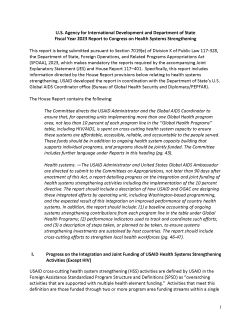This report is being submitted pursuant to Section 7019(e) of Division K of Public Law 117-328, the Department of State, Foreign Operations, and Related Programs Appropriations Act (SFOAA), 2023, which makes mandatory the reports required by the accompanying Joint Explanatory Statement (JES) and House Report 117–401. Specifically, this report includes information directed by the House Report provisions below relating to health systems strengthening. USAID developed the report in coordination with the Department of State’s U.S. Global AIDS Coordinator office (Bureau of Global Health Security and Diplomacy/PEPFAR).
The House Report contains the following:
The Committee directs the USAID Administrator and the Global AIDS Coordinator to ensure that, for operating units implementing more than one Global Health program area, not less than 10 percent of each program line in the ‘‘Global Health Programs’’ table, including HIV/AIDS, is spent on cross-cutting health system capacity to ensure these systems are affordable, accessible, reliable, and accountable to the people served. These funds should be in addition to ongoing health system capacity building that supports individual programs, and programs should be jointly funded. The Committee includes further language under Reports in this heading (pg. 43).
Health systems. —The USAID Administrator and United States Global AIDS Ambassador are directed to submit to the Committees on Appropriations, not later than 90 days after enactment of this Act, a report detailing progress on the integration and joint funding of health systems strengthening activities including the implementation of the 10 percent directive. The report should include a description of how USAID and OGAC are designing these integrated efforts by operating unit, including Washington-based programming, and the expected result of this integration on improved performance of country health systems. In addition, the report should include: (1) a baseline accounting of ongoing systems strengthening contributions from each program line in the table under Global Health Programs; (2) performance indicators used to track and coordinate such efforts; and (3) a description of steps taken, or planned to be taken, to ensure systems strengthening investments are sustained by host countries. The report should include cross-cutting efforts to strengthen local health workforces (pg. 46-47).
I. Progress on the Integration and Joint Funding of USAID Health Systems Strengthening Activities (Except HIV)
USAID cross-cutting health system strengthening (HSS) activities are defined by USAID in the Foreign Assistance Standardized Program Structure and Definitions (SPSD) as “overarching activities that are supported with multiple health element funding.” Activities that meet this definition are those funded through two or more program area funding streams within a single implementing mechanism/project and are expected to impact and support multiple health program areas. Cross-cutting HSS activities take a comprehensive approach aimed to result in system-wide efficiencies and/or improved integrated health system performance. USAID cross-cutting HSS activities in this report do not include the full universe of USAID HSS activities and in particular those that are undertaken by a single program area of the Global Health Program (GHP) account (e.g., community health worker training in malaria diagnosis and treatment), which fall within different SPSD definitions related to specific program aspects of service delivery and health systems. Individual health program area health system strengthening interventions also benefit partner country health systems, especially through helping to meet program area goals and improve health outcomes. Except for HIV/AIDS, which is addressed in the PEPFAR section of this report, each USAID-implemented program area has an SPSD code for cross-cutting HSS; by definition, funds programmed under these codes support integrated, or cross-funded, HSS activities. This aligns with the language in the House Report, which focuses on HSS activities that are “jointly funded.” USAID continues to take steps to better integrate HSS activities across programs, guided by Agency policy and priorities for strengthening integrated health systems, including the Agency’s Vision for Health System Strengthening 2030.
The House Report that accompanied the FY 2022 SFOAA contained provisions similar to those above. In response to the FY 2022 House Report directive, the Bureau for Global Health (GH) updated its tracking mechanisms and programming guidance for all operating units to better meet the directive. The FY 2022 funds have now been programmed through the FY 2022 OP, which is used for all USAID Global Health Programs with the exception of HIV/AIDS2, and this report is based on enhanced data gained as a result of this update

